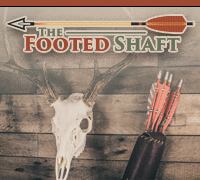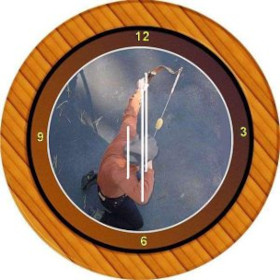The Medieval arrow, like its present day descendant, consisted of tree parts: the stele (shaft), the arrow head, and the fletching (feathers).57 Ascham notes that different types of arrows had different lengths of fletching. A war missile would have large feathers. Target and small game arrows had smaller.58 But, not just any feathers were acceptable: Medieval archers preferred the pinion (flight) feathers of the bird's wing.59 The most commonly used feathers were from the grey goose: "These were tough, durable, cheap and in plentiful supply".60 There were three feathers to a shaft, fixed by "binding, adhesion, or a combination of both"61 Consistant with present day practice, the cock feather was coloured differently from the other two feathers. Ascham wrote:
"...surelye it standeth with good reaso(n) to have the cocke fether black or greye, as it were to gyue a man warning to noche right."62 In order to preserve the stele, it was coated with a moisture repellent copper solution called virido greco.64
As for the stele of the arrow, Ascham lists fourteen different woods which were used in his day. They include brazil, birch, oak, and ash. But as far as he is concerned, ash was the best for war arrows since it was "both swifter and heuier, is more fit for sheaafe arrows."63
The arrow nock, the place for the bowstring to attach, was also composed of many types. Depending upon the arrow and corresponding width of the bowstring, the nock could be small, shallow, wide, deep, or any cobination of these. Some arrows even had a double nock. In terms of a war arrow, the best nock was deep and long to insure that the string did not slip during the draw.65
The last of the three parts of an arrow is the head. Medieval arrow heads were of three main types: the 'y'-shaped forked hunting head, the leaf shaped broadhead, and the bodkin head.66 The famed bodkin point, unlike the broadhead, was reserved strictly for war. It was a four-sided spike developed to penetrate plate armour.67 Stayner notes that the 6 inch socketed heads were often waxed to aid penetration.68
The origin of the English longbow is lost in the mist of time. The currently accepted theory was set at the turn of the twentieth century by Morris in his superb study, The Welsh Wars of Edward I. Morris maintained the weapon was of Welsh descent and was introduced into England's military arsenal around the turn of the fourteenth century.69 Sir Charles Oman, in his classic, A History of the Art of Warfare in the Middle Ages, took Morris' idea and perpetuated it.70
Morris is undoubtedly correct in his assumption that the longbow was foreign to both the Saxons and the Normans. The Bayeux tapestry shows only one Saxon bowman with a short bow. The rest of Harold's forces use the shield and battle axe. The Norman archers from Louviers and Evreux who, according to tradition, won William's victory for him, also used the short wooden bow.71
Morris based his conclusion that Southern Wales was the home of the longbow from the historical writings of the late twelfth century cleric Silvester Giraldus Cambrensis.72 Cambrensis, youngest son of William de Barri, was in his lifetime: Archdeacon of Brecknock, servant of King Henry II and his son, Richard the Lion-Hearted, and co-adjutor in administration with the Bishop of Ely of Richard's realm during the Third Crusade. But the one accomplishment Cambrensis is best remembered for is his chronicle, The Itinery Triugh Wales.73
In his chronicle, Cambrensis describes the archery of the Southern Welsh. He notes that a tribe called the Venta were "more accustomed to war, more famous for valor, and more expert in archery, than those of any other part of Wales".74 The Venta were a stubborn people, unlike the Normans who followed the codes of chivalry, their "mode of fighting consists in chasing the enemy or in retreating.".75 They were guerrilla fighters, and the bow was perfectly suited for them.
Morris, reading about the Norman-Venta encounters, misinterpreted a key passage of The Itinery Triugh Wales:
"Especially we get from Gerald (Gerald de Barri or Giraldus Cambrensis) a valuable picture of the archers of Gwent, with their 'bows made of wild elm, unpolished, rude and uncouth, not only calculated to shoot an arrow to a great distance, but also to inflict very severe wounds in a close fight'."76
The correct translation of this passage according to Foster and Hoare, The Historical Works of Giraldus Cambrensis, should be: "Yet the bows used by these people (the Venta) are not made of horn, ivory, or yew, but of wild elm; unpolished, rude and uncouth, but stout; not calculated to shoot an arrow to a great distance, but to inflict very severe wounds in a close fight."77
Therefore, the twelfth century Welsh weapon could not be a longbow. It did not have the range of a longbow, nor does Cambrensis mention any extraordinary length. The bow of Cambrensis' England was the short Norman bow. Surely an astute observer such as the Archdeacon would not have failed to notice the most obvious difference between a continental and a longbow.
It is now apparent that the longbow was already in England during the time of Edward I. Edward simply adopted the longbow because it was superior in range and equally as powerful as the Welsh bow. But as Morris and Oman pointed out, the catalysis for the use of the longbow was found in Wales.78
There is good evidence to show that the longbow was introduced into England from the Scandinavian Countries, the question that remains is when. The best answer is probably sometime during the many Danish invasions before the 1066 landing of William the Conqueror.79 E.G. Heath, author of The Grey Goose Wing and A history of Target Archery, notes that several well-preserved longbows were recovered from Saxon burial galleys found at Nydam Moor in Denmark in 1863. "These bows have been scientifically dated between 200 and 400 A.D..."80 Dr. Elizabeth Munksgaard, Assistant Keeper of the Prehistoric Department, verified that the Migration Period, Nydam Find artifacts are in the National Museum of Danmark. There are seven Nydam bows which closely resemble the Flodden, Mary Rose, Hedgeley Moor and Mendlesham artifacts. The Nydam bows are self wooden bows, of 5 feet 7 inches to 6 feet long, 'D'-shaped, and one of the bows has a nock of horn.These bows differ from the Renaissance English weapons in only two ways: they have ornamental carvings and have a binding of thread and pitch.81
Dr. Adali Lieshf, curator of the Viking Ship Room, Museum of National Antiquities, University of Oslo, recently discovered a Viking longbow. The bow was found in a cremation grave on the farm Torshov in Gjerdrum, Akerhus. All the wood has deteriorated, but the iron bands which reinforced the wooden stave remains. Lieshf described the artifact this way: "There are, however, some unpublished fragments of iron, by me identified as parts of a long bow made of wood reinforced with and riveted to iron bands with pointed ends somewhat longer than the wooden part."82
A final argument supporting the Scandinavian origins of the longbow comes from Dr. Lynn White, Jr., noted medievalist, who writes that in old Irish there are two words for bow: one is for a short bow, and its root is Celtic; the other is for a longbow, and its root is Norse.83 Given this information, it is apparent that the yew wood longbow is a very old weapon. It can be traced from pre-Migration People to Danish Vikings to English Medieval yeoman soldiers.
The Medieval English longbow was a superb weapon. Incrcdibly powerful, rapid, and deadly, it was a socially levelling force. With it the yeoman was superior to the knight, and the Kingdom of England was the master of Western Europe. Yet, important as it was, the longbow was an everyday object. Because it was so common, few longbows survive.
When myth is separated from reality, and the few remaining artifacts are examined, what information is available paints a far different picture than the currently accepted image. The weapon was of Scandinavian, not Welsh origin. It was known to pre-Migration Celts and Vikings; made of yew wood, not ash, boxwood or elm; approximately 6 feet long, shot an arrow roughly 27 inches in length, and had an effective range of circa 200 yards.














